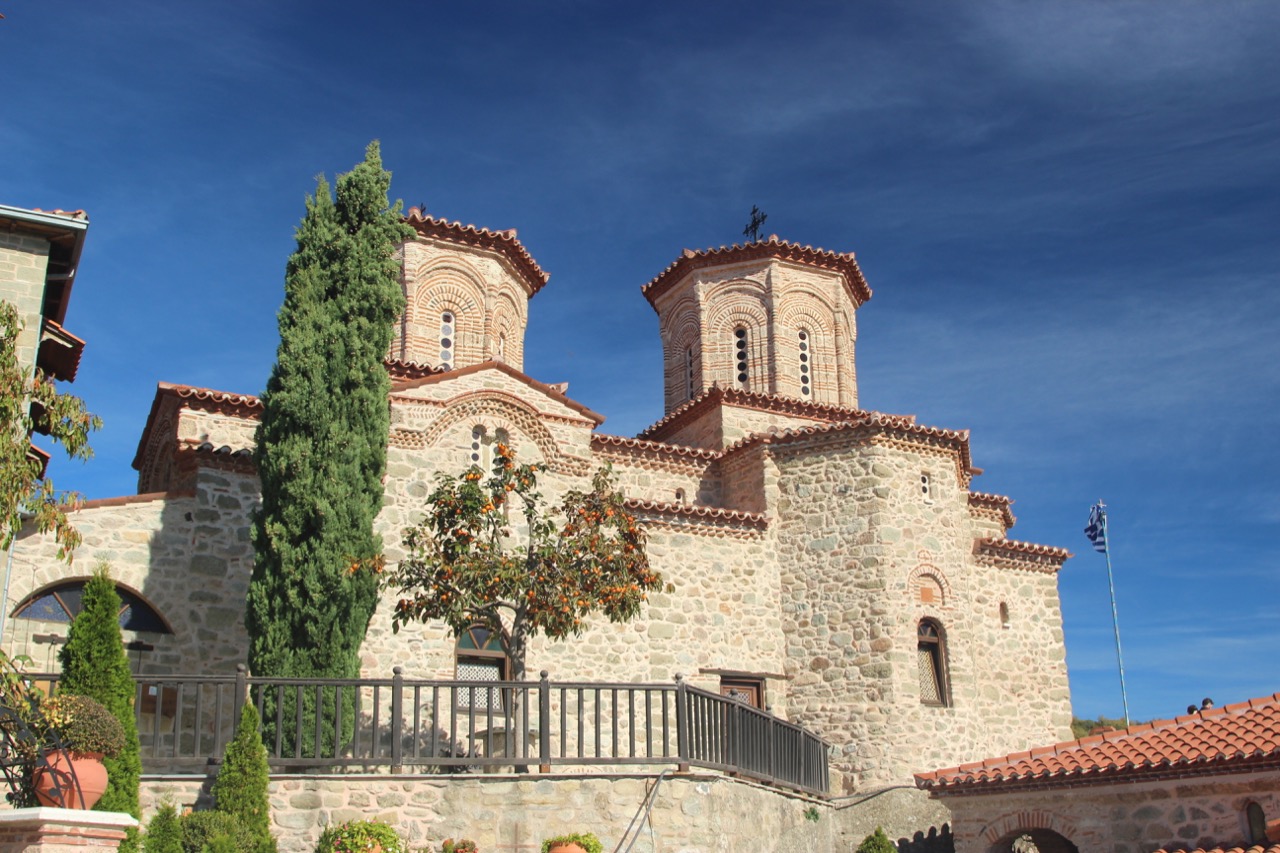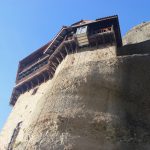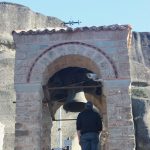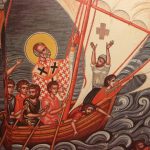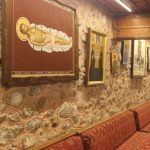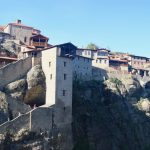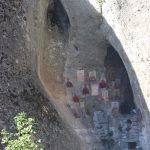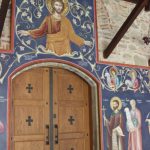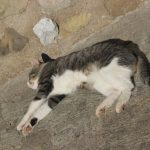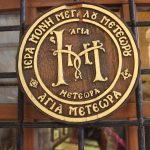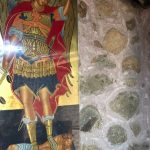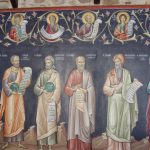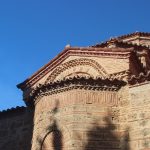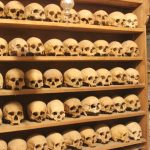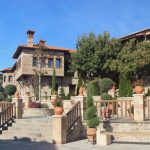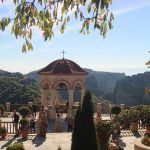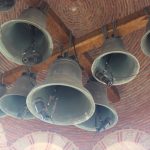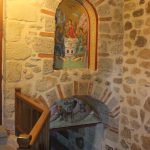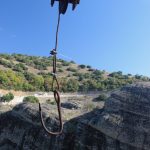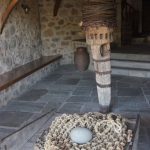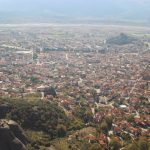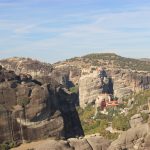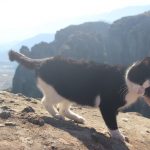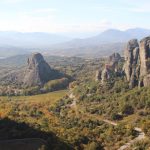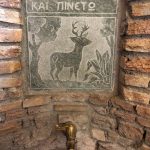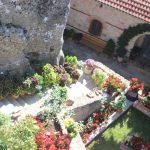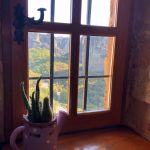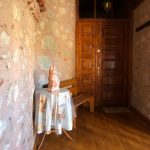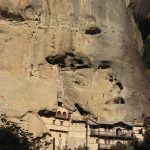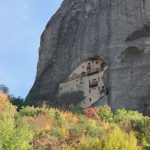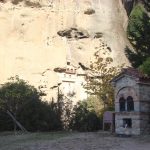Yes. There it is: the other monastery pun. The pun I have been waiting to make! This time, we were both staring at them (like yesterday) and walking up 10,000 stairs to get to them (my phone reports 89 floors climbed, give or take). Today we had a private tour of the monasteries through the tour company that was right down the stairs from our ABB. How convenient. The six of us had a small tour bus all to ourself, with our tour guide Christof and driver Konstantine.
Learning and monasteries abound!
I got the answer to my question yesterday about who the heck would build a monastery here and why. Back in the 11th and 12th centuries, hermits had taken up residence in the stone caves. The higher in the sky they were, the closer to god. At one time, there were about 300+ monks living in solitude in the numerous caves. I think this just makes the caves an apartment complex at that point – all these religious dudes living on a cliff face alone but yet together (but definitely still alone).
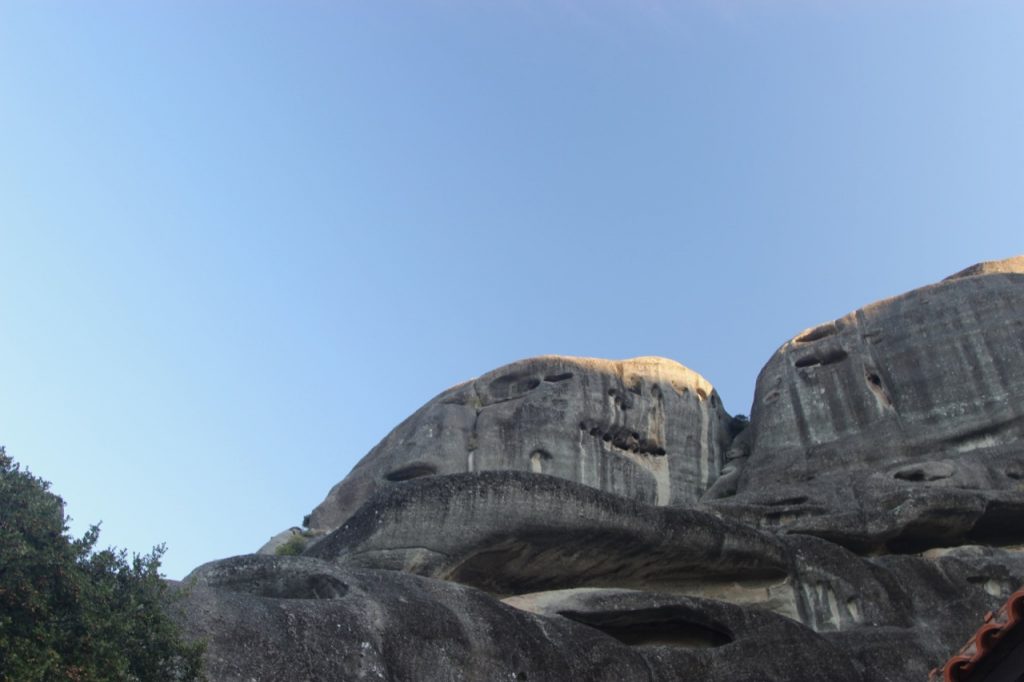
At one point, one of the monks proposed moving into structures for warmth and to attract more followers. Slowly, over the centuries, the monasteries were built up on high clifftops for this very purpose. Naturally, this day would contain lots of icons, because what else you gonna paint in the 13th century onwards?
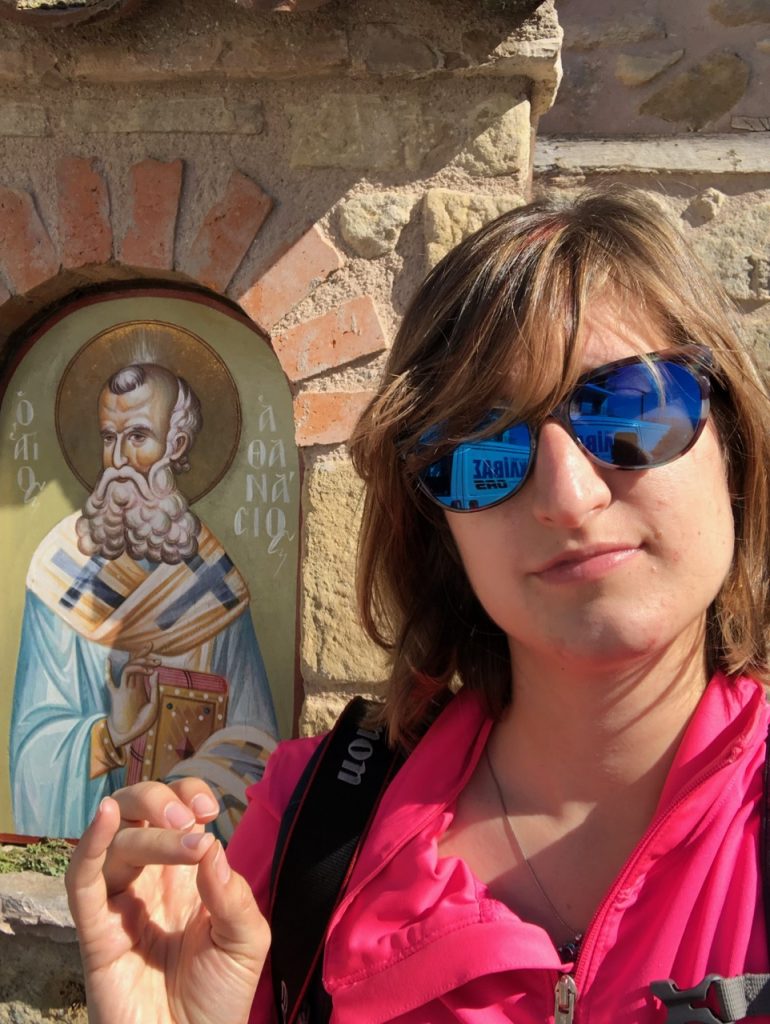
People throughout history like to burn down the monasteries or destroy them in some way. The pesky Turks burned them down at some point, and then the Nazis leveled the town of Kalambaka and the monasteries during WWII. All of the monasteries have undergone extensive restorations since WWII, with some ruins of the original buildings still remaining, as well as a few of the cave holes.
I am beginning to really appreciate what an asshole neighbor Turkey is to Greece (and probably vice-versa, as we only get the Greece side) – burning stuff, destroying precipitously-placed monasteries, occupying lands for 400 years, currently fighting over the ownership of the Aegean Sea, etc. Anyway, our guide described to us the significance of the golden two-headed eagle flag (the flag of the Byzantine empire, the eagle sees everything and you cannot hide from its two heads or the emperor) and the Greek flag (with its nine strips, white cross because religion, and blue because Aegean Sea, it’s is Greece’s sea, so back off, Turkey), which are always displayed together in Meteora.
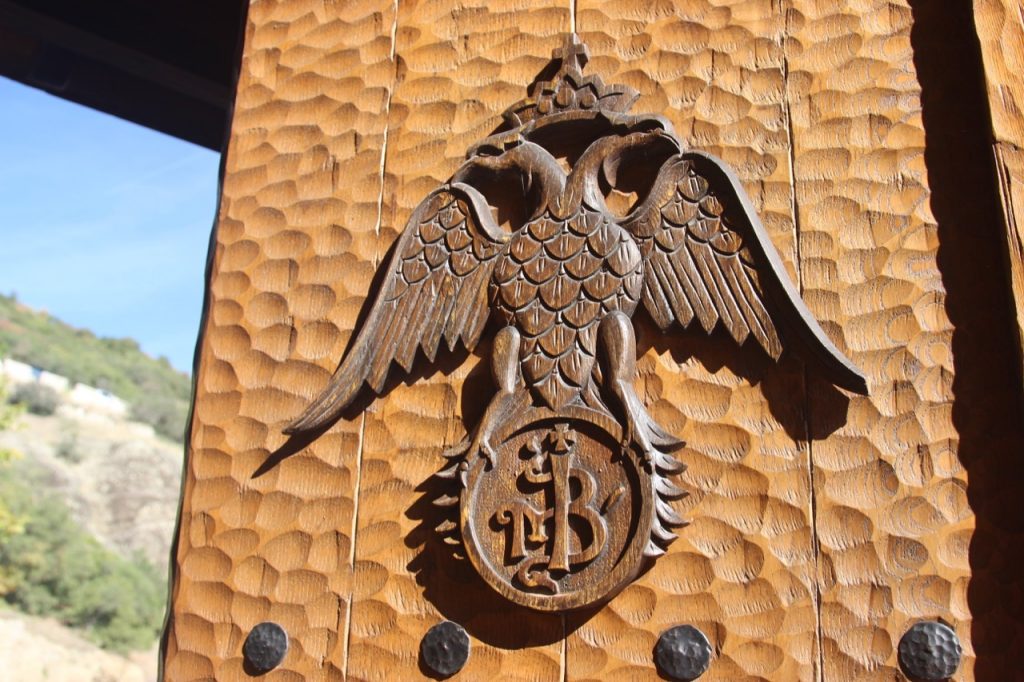
Our tour began at the first church the monks built (which was not on a clifftop, as they needed somewhere slightly nicer than a cliff to go sometimes) and proceeded to go around the remaining five monasteries that we hadn’t seen. This promises a lotta iconic art. Rhett’s dad is gonna have an excellent day.
First stop, the Monastery of St Nikolaos. It had a medium amount of uneven stairs to get in. This one had a fancy seating area for the monks, a space for them to live, and then a top area and a chapel that offered great views and even greater iconic art. I suppose that it was not good to draw genitals on the naked figures back in the 16th century, so it looks like everyone has fupas. Attractive. Fupas aside, this monastery felt cozy inside with its three low-ceilinged floors.
This one was founded by a wealthy benefactor who converted to Christianity and made this monastery fancy. I noticed that the monasteries sell wine, despite the fact that the monks and nuns can’t drink the wine. How do they know if it’s even good? I have many questions.
After that, we hit up the Monastery of Great Meteoron, which is the biggest one that has the most stairs, like 300+. You also have to walk a slopey ways down and then up again to get to this monastery. I suppose these stairs beat ladders on the side of the rocks or being pulled up in a rope basket with pulleys. This one had an impressive museum and sprawling grounds (as much as one can sprawl on the top of a rock). It had a little hallway where you could check out information on the significance of the monastery and how people in the town resisted the nazis. There was even a neat little painting of hitler being chucked off a monastery. I dig it.
Our last monastery before lunch was Varlaam, the second biggest and second highest (and it had half the number of stairs – yeah!). It was a hike to get to, down the side of a mountain, across a gorge on a bridge, and then up eternally. This one had an old preserved net meant for hauling monks up and down the sides of the monastery back in the day. Hard pass, I will take the stairs. Now, they have a little gondola thing they ride across. I feel like monks long ago would frown on this. The tourist crowds were picking up and we left this one for lunch!
After lunch of Greek food (because why else are we here), we headed to the James Bond monastery (actually known as the Holy Trinity monastery), where they filmed a scene from For Your Eyes Only. This one was a pain in the butt to get to and there were far less people despite its claim to fame. The movie inspired a lot of tourism in Meteora, which started to lead to an uptick in tourism, funds, and rebuilding of the monasteries. The Eyrie from Game of Thrones is also based on this region.
Anyway, this monastery was the most pain in the butt to reach, with the longest hike, but it offered the best view of the surrounding area. Superb!
Lastly, we checked out the nunnery of Roussanou, which was Russian Orthodox in origin. This one was a cozy nunnery surrounded by gardens and it had neatly-kept wooden hallways and scriptures. I watched one nun dink around on an iPhone X as she was perched next to 16th century art. Technology is not full lost to the extremely pious, it seems.
Our final stop was a tucked-away location showing some of the more well-preserved hermitages and the wooden structures and ladders outside of them. The Greek government has spent considerable time renovating some of the walls covering the cave entrances. You can’t go inside them today and they are abandoned, but it’s a good look into what they might have been years ago.
We learned how monks spend their days. They wake up at 330, pray til 5am, then do more chores and praise the lord for a while longer. They may lead masses or perform repairs or study. Every day. I feel like the “pray in your room til 5am” part is really code for “sleep until 5” because who of your monk brethren is checking?
Anyway, if you commit some kind of monk foul, you are banished to monk jail to atone, which is a rickety structure up in a cave not too far from the monasteries. So maybe if someone caught you sleeping til 5am….that’s where you went!
The monk population is in decline. Our guide speculated that soon the monasteries would either become solely museums and not monasteries, or would close to the public (unlikely, he thinks). There is another enclave near Thessaloniki where the monks and nuns prefer to spend their days.
We bid farewell to our wonderful guide and driver at the station and hopped on our ~5hr train ride back to Athens. I am thoroughly done with stairs and stepping on rocks in the exact middle of my left foot repeatedly (I have done that about 7 times today). About midway, some asshole, probably drunk, rendered the toilet useless by peeing everywhere SOMEHOW and we all held it real good til we got to Athens. One fight with a super stupid subway ticket machine later which didn’t take 20s despite advertising the fact that it indeed took 20s, and we were in the home sweet home of our central Athenian abode.
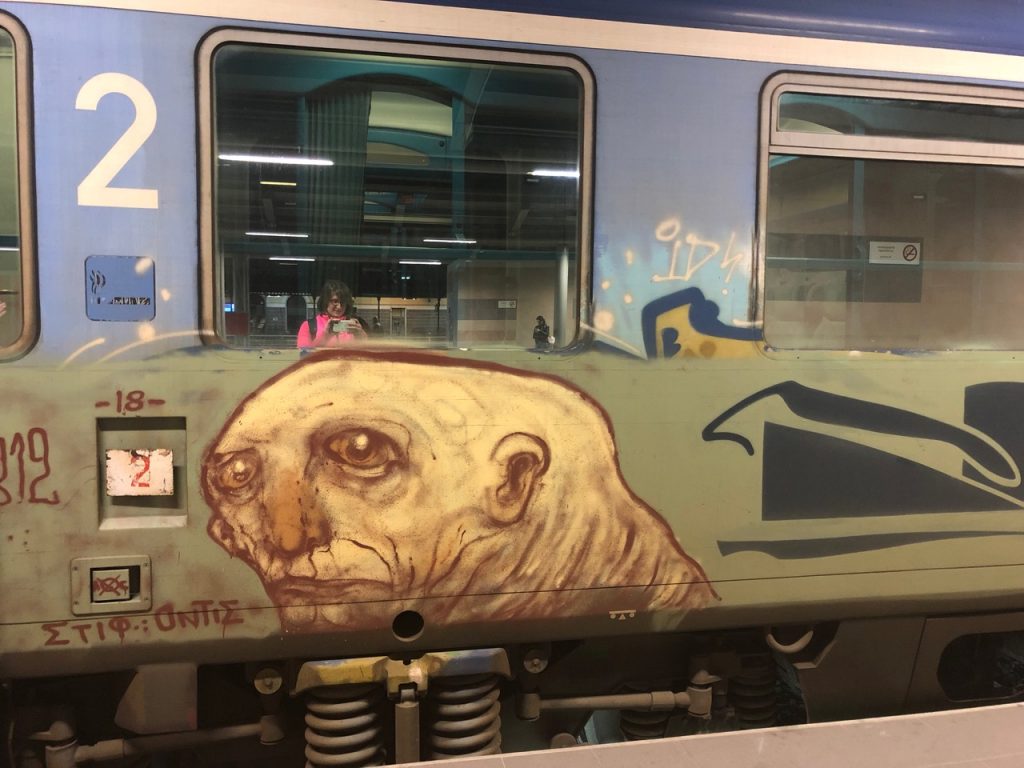
Tomorrow we plan to aimlessly wander around the Acropolis and maybe hit up the Turkish bath!
